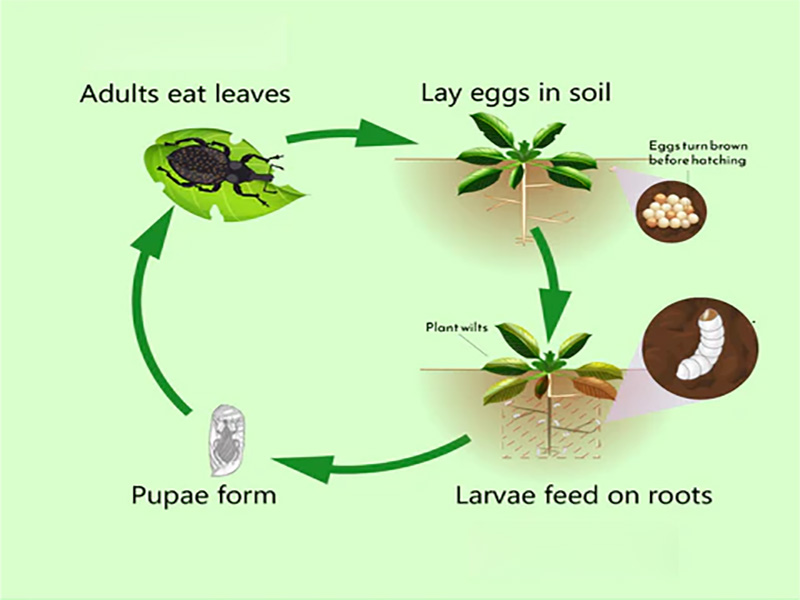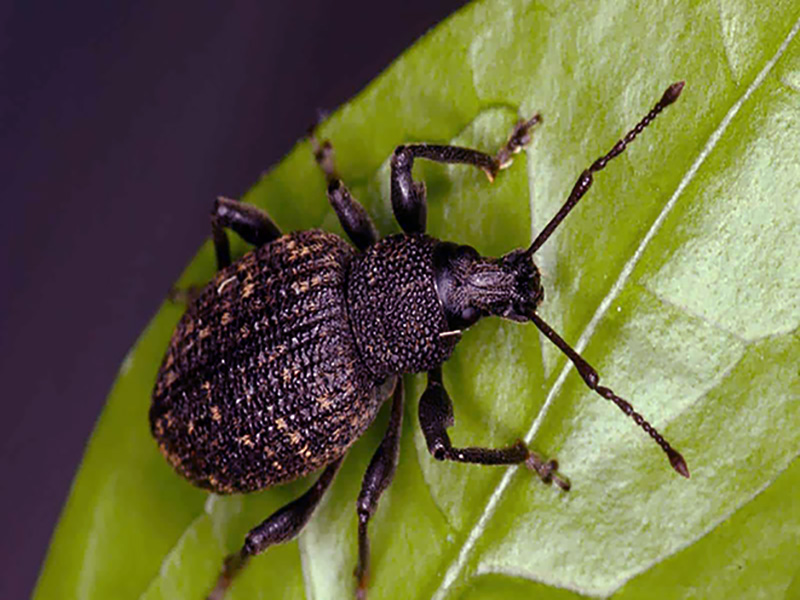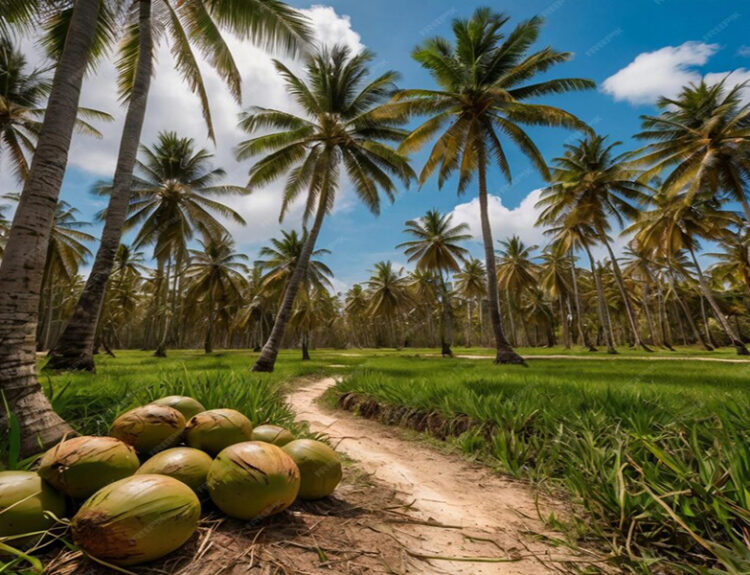In this series, we will delve deep into the world of the black weevil, a destructive pest that poses a significant threat to Sri Lanka’s coconut industry. Over the next few articles, we will explore the biology, behavior, and impact of the black weevil, as well as the various strategies that have been employed to control its populations. Prepare to be informed and engaged as we uncover the challenges and potential solutions associated with this insidious pest.
The black vine weevil, Otiorhynchus sulcatus, is a significant pest of ornamental plants, particularly evergreens like yew, hemlock, and rhododendron. Both as adults and larvae, they feed on a wide range of plants, including deciduous and herbaceous species. While the larvae are most destructive, feeding on roots and causing plant decline, adults can also damage foliage.
The black vine weevil, Otiorhynchus sulcatus, is a destructive pest that can cause significant damage to ornamental plants. Both the adult beetles and their larvae feed on a variety of plants, leading to plant decline and even death.
The black vine weevil, Otiorhynchus sulcatus, is a parthenogenetic insect, meaning females can reproduce without mating. Adult females typically lay around 200 eggs, which hatch in two to three weeks. Larvae initially feed on rootlets but move to larger roots as they grow and develop, molting five or six times during their life cycle. While most weevils overwinter as larvae, some adults may survive and continue feeding and laying eggs during a second season.
Adult black vine weevils cause noticeable damage to broad-leaved evergreens and other host plants by creating marginal notches in the leaves. On yew plants, you can detect weevil infestations by inspecting the central area near the main stems for notched or severed leaves, which are the result of adult weevils feeding during the night. These shiny black, flightless females measure about 3/8 to 1/2 inch in length and are difficult to spot, as they drop to the ground when disturbed and blend into their surroundings. Although adult feeding typically doesn’t lead to significant plant harm, the telltale notching on leaves serves as an indicator of their presence, signaling the need to take action to prevent damage from the next generation’s larvae.
The larva inflicts the most serious damage by feeding on plant roots and girdling the lower stems, which disrupts the flow of water and nutrients, potentially leading to the plant’s death. These larvae are legless, C-shaped, and white with reddish-brown heads. They can typically be found in the soil surrounding the roots, at depths ranging from 3/4 inch to 16 inches. Pupation takes place just below the soil surface, where the pupae, which are white with prominent legs and antennae, undergo transformation into adults.
he black weevil, Otiorhynchus sulcatus, is a destructive pest that can cause significant damage to ornamental plants, including coconut palms. While it is generally considered a pest, there are no known direct benefits to the coconut industry. In fact, the black weevil can have a negative impact on coconut production by damaging trees and reducing yields.
It’s important to note that the black weevil is a different species than the red palm weevil, which is a more serious pest of coconut palms. The red palm weevil can cause severe damage to coconut trees, leading to their death.
Life cycle of black weevil

Overwintering larvae feed on roots deep in the soil and pupate in May. Adults dig their way out of the ground in mid-June and crawl up the plants to feed. Feeding occurs mostly at night and adults hide in dark places on the plants or on the ground during the day. When disturbed, they quickly drop the ground. After one to two weeks of feeding, adults crawl or drop to the ground to lay eggs. For several weeks, they alternately feed and lay eggs. Eggs are dropped indiscriminately to the ground under the plants (as many as 500 per female!) over her entire life. If houseplants are placed under shrubs during the summer, eggs may be deposited on the soil of the containers. Ten to 14 days later the grubs hatch and burrow down into the soil searching out roots to feed on. Occasionally, a few adults can be found in houses during winter, apparently able to overwinter in this stage. Most die in the fall, and larvae survive the winter in the soil. There is only one generation per year.
The black vine weevil, Otiorhynchus sulcatus, is a destructive pest that can cause significant damage to ornamental plants. Both the adult beetles and their larvae feed on a variety of plants, leading to plant decline and even death.
- Adult females lay up to 500 eggs in the soil near the base of the plant.
- Larvae overwinter in the soil and emerge as adults in late spring.
- Larvae hatch and feed on roots from midsummer to fall and again in the spring.
- Some adults may overwinter, leading to earlier egg-laying
Adults require 21-28 days of foliage feeding prior to producing eggs. They may lay as many as 500 eggs over a period of 14-21 days. Eggs are laid in the soil near the base of host plants. They hatch in 10-14 days into small larvae that feed on roots until temperatures decrease in the fall and cause them to move deeper into the soil where they overwinter. Occasionally, some adults may survive the winter inside homes. Only one generation occurs each year in Pennsylvania.
The black vine weevil, Otiorhynchus sulcatus, is a destructive pest that can cause significant damage to ornamental plants, including coconut palms. While it does not pose a direct threat to the coconut industry, it can indirectly impact coconut production by damaging landscape plants that may be used as windbreaks or shade trees for coconut plantations.
Advantages:
- None: The black vine weevil does not provide any known benefits to the coconut industry.
Disadvantages:
- Damage to ornamental plants: The black vine weevil can cause severe damage to a variety of ornamental plants, including rhododendrons, yews, and hemlocks. This can negatively impact the aesthetic value and health of landscapes.
Indirect impact on coconut production: While the black vine weevil does not directly target coconut palms, it can indirectly affect coconut production by damaging landscape plants that provide shade or wind protection. This can lead to increased stress on coconut trees and potentially reduce yields.
The black vine weevil, Otiorhynchus sulcatus, is a destructive pest that can cause significant damage to ornamental plants, including coconut palms. While it does not pose a direct threat to the coconut industry, it can indirectly impact coconut production by damaging landscape plants that may be used as windbreaks or shade trees for coconut plantations. To control black vine weevils, it is important to monitor plants for signs of infestation, remove and destroy infested plants, apply beneficial nematodes, use cultural control methods, and consider using insecticides if necessary. By taking these steps, coconut growers can help protect their ornamental plants and minimize any indirect impact on coconut production.
The black vine weevil, Otiorhynchus sulcatus, is a destructive pest that can cause significant damage to ornamental plants, including coconut palms. While it does not pose a direct threat to the coconut industry, it can indirectly impact coconut production by damaging landscape plants that may be used as windbreaks or shade trees for coconut plantations. To control black vine weevils, it is important to monitor plants for signs of infestation, remove and destroy infested plants, apply beneficial nematodes, use cultural control methods, and consider using insecticides if necessary. By taking these steps, coconut growers can help protect their ornamental plants and minimize any indirect impact on coconut production.





